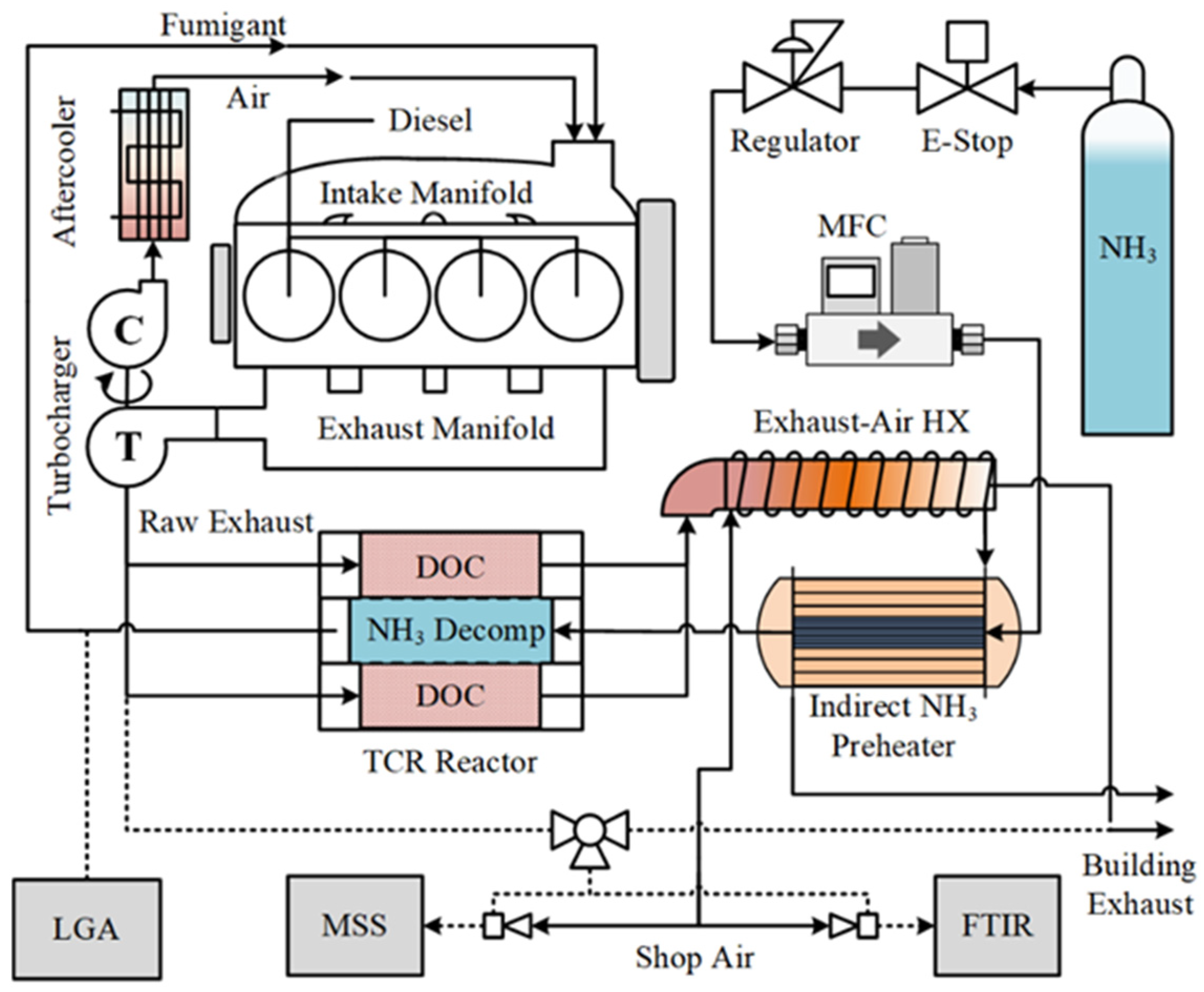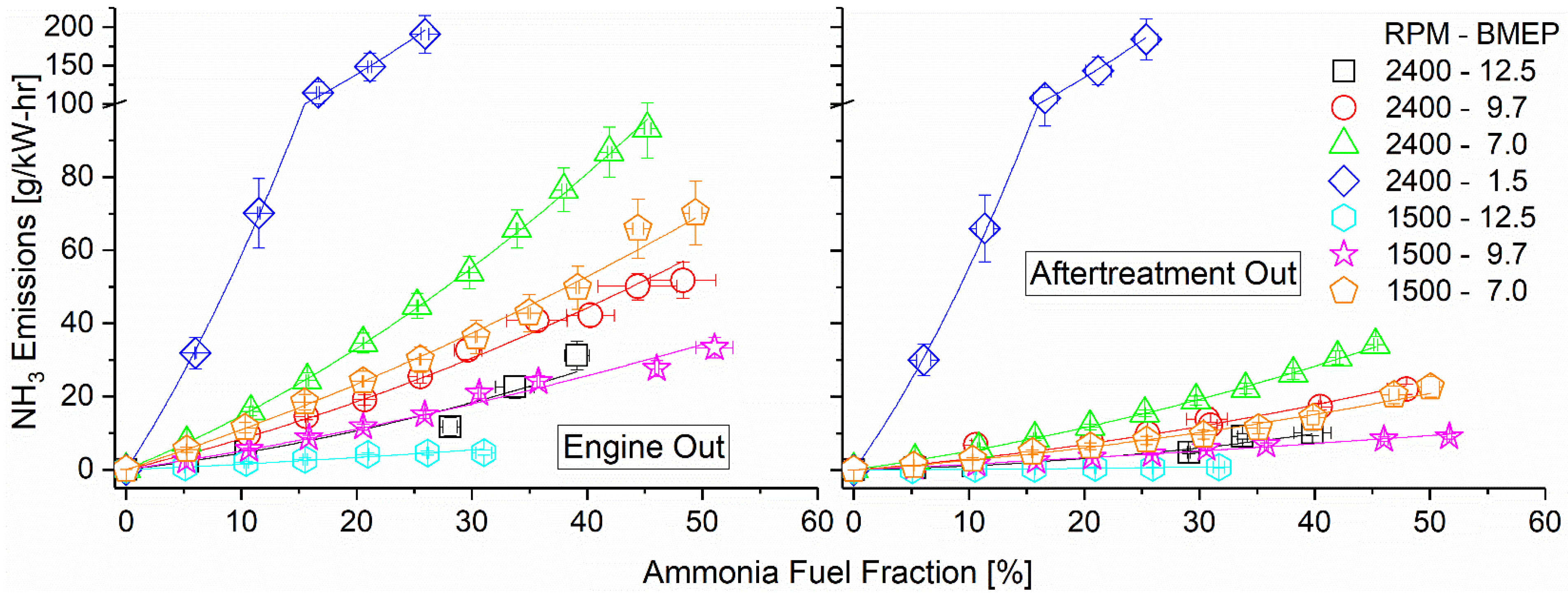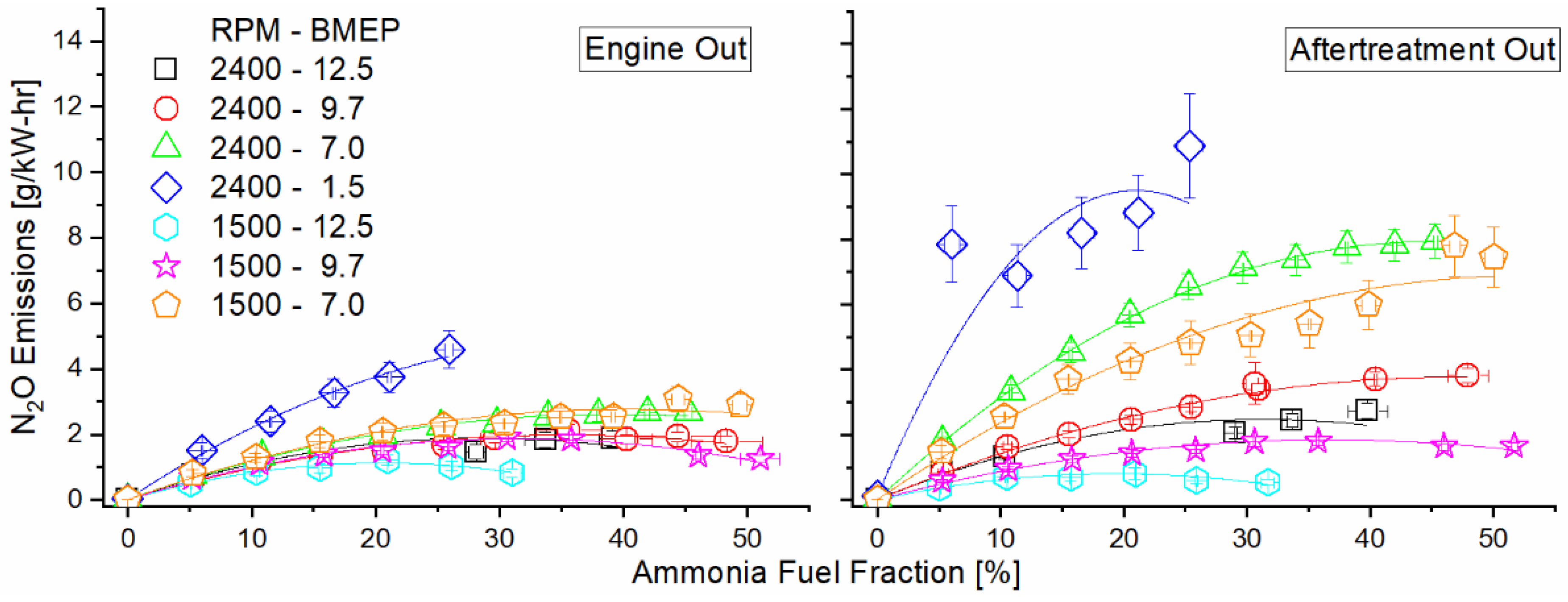Thermochemical Recuperation to Enable Efficient Ammonia-Diesel Dual-Fuel Combustion in a Compression Ignition Engine
Abstract
:1. Introduction
2. Experimental Methods
3. Results and Discussion
3.1. Ammonia Thermochemical Recuperator Performance
3.2. Engine Efficiency and Combustion Performance
3.3. Engine Emissions
4. Conclusions
Supplementary Materials
Author Contributions
Funding
Institutional Review Board Statement
Informed Consent Statement
Acknowledgments
Conflicts of Interest
References
- Solomon, S.; Plattner, G.; Knutti, R.; Friedlingstein, P. Irreversible climate change due to carbon dioxide emissions. Proc. Natl. Acad. Sci. USA 2009, 106, 1704–1709. [Google Scholar] [CrossRef] [Green Version]
- Schmale, J.; Flanner, M.; Kang, S.; Sprenger, M.; Zhang, Q.; Guo, J.; Li, Y.; Schwikowski, M.; Farinotti, D. Modulation of snow reflectance and snowmelt from Central Asian glaciers by anthropogenic black carbon. Sci. Rep. 2017, 7, 40501. [Google Scholar] [CrossRef]
- Schwarz, J.P.; Gao, R.S.; Perring, A.E.; Spackman, J.R.; Fahey, D.W. Black carbon aerosol size in snow. Sci. Rep. 2013, 3, 1356. [Google Scholar] [CrossRef] [PubMed]
- Sacks, J.; Kirrane, E.; Luben, T.; Oesterling Owens, E. Provisional Assessment of Recent Studies on Health Effects of Particulate Matter Exposure; EPA/600/R-12/056; U.S. Environmental Protection Agency: Washington, DC, USA, 2012; p. 65.
- Moradi, R.; Groth, K.M. Hydrogen storage and delivery: Review of the state of the art technologies and risk and reliability analysis. Int. J. Hydrogen Energy 2019, 44, 12254–12269. [Google Scholar] [CrossRef]
- Ummary, S. Renewable Energy to Fuels through Utilization of EnergyDense Liquids (REFUEL) Program Overview. Available online: https://arpa-e.energy.gov/sites/default/files/documents/files/REFUEL_ProgramOverview_FINAL.pdf (accessed on 21 September 2021).
- Chisalita, D.A.; Petrescu, L.; Cormos, A.M.; Cormos, C.C. Assessing Energy and CO2 Emission Reduction from Ammonia Production by Chemical Looping as Innovative Carbon Capture Technology. In Proceedings of the 28th European Symposium on Computer Aided Process Engineering, Graz, Austria, 10–13 June 2018; Elsevier B.V.: Graz, Austria, 2018; Volume 43, pp. 1269–1274. [Google Scholar]
- International Fertilizer Industry Association. Fertilizers, Climate Change and Enhancing Agricultural Productivity Sustainably; International Fertilizer Industry Association: Paris, France, 2009; pp. 1–30. [Google Scholar]
- Wang, L.; Xia, M.; Wang, H.; Huang, K.; Qian, C.; Maravelias, C.T.; Ozin, G.A. Greening Ammonia toward the Solar Ammonia Refinery. Joule 2018, 2, 1055–1074. [Google Scholar] [CrossRef] [Green Version]
- Reese, M.; Marquart, C.; Malmali, M.; Wagner, K.; Buchanan, E.; McCormick, A.; Cussler, E.L. Performance of a Small-Scale Haber Process. Ind. Eng. Chem. Res. 2016, 55, 3742–3750. [Google Scholar] [CrossRef]
- Thomas, G.; Parks, G. Potential Roles of Ammonia in a Hydrogen Economy. Energy 2006, 1–23. [Google Scholar]
- Comotti, M.; Frigo, S. Hydrogen generation system for ammonia-hydrogen fuelled internal combustion engines. Int. J. Hydrogen Energy 2015, 40, 10673–10686. [Google Scholar] [CrossRef]
- Wang, W.; Herreros, J.M.; Tsolakis, A.; York, A.P.E. Ammonia as hydrogen carrier for transportation; Investigation of the ammonia exhaust gas fuel reforming. Int. J. Hydrogen Energy 2013, 38, 9907–9917. [Google Scholar] [CrossRef] [Green Version]
- Kobayashi, H.; Hayakawa, A.; Somarathne, K.D.K.A.K.A.; Okafor, E.C. Science and technology of ammonia combustion. Proc. Combust. Inst. 2019, 37, 109–133. [Google Scholar] [CrossRef]
- Reiter, A.J.; Kong, S.C. Combustion and emissions characteristics of compression-ignition engine using dual ammonia-diesel fuel. Fuel 2011, 90, 87–97. [Google Scholar] [CrossRef] [Green Version]
- Reiter, A.J.; Kong, S.C. Demonstration of compression-ignition engine combustion using ammonia in reducing greenhouse gas emissions. Energy Fuels 2008, 22, 2963–2971. [Google Scholar] [CrossRef]
- Frigo, S.; Gentili, R. Analysis of the behaviour of a 4-stroke Si engine fuelled with ammonia and hydrogen. Int. J. Hydrogen Energy 2013, 38, 1607–1615. [Google Scholar] [CrossRef]
- Liu, R.; Ting, D.S.K.; Checkel, M.D. Ammonia as a fuel for SI engine. SAE Tech. Pap. 2003, 1. [Google Scholar] [CrossRef]
- Gill, S.S.; Chatha, G.S.; Tsolakis, A.; Golunski, S.E.; York, A.P.E. Assessing the effects of partially decarbonising a diesel engine by co-fuelling with dissociated ammonia. Int. J. Hydrogen Energy 2012, 37, 6074–6083. [Google Scholar] [CrossRef]
- Updyke, K.M.; Nguyen, T.B.; Nizkorodov, S.A. Formation of brown carbon via reactions of ammonia with secondary organic aerosols from biogenic and anthropogenic precursors. Atmos. Environ. 2012, 63, 22–31. [Google Scholar] [CrossRef]
- Behera, S.N.; Sharma, M. Investigating the potential role of ammonia in ion chemistry of fine particulate matter formation for an urban environment. Sci. Total Environ. 2010, 408, 3569–3575. [Google Scholar] [CrossRef]
- Wang, S.; Nan, J.; Shi, C.; Fu, Q.; Gao, S.; Wang, D.; Cui, H.; Saiz-Lopez, A.; Zhou, B. Atmospheric ammonia and its impacts on regional air quality over the megacity of Shanghai, China. Sci. Rep. 2015, 5, 15842. [Google Scholar] [CrossRef] [Green Version]
- Johnson, T.; Joshi, A. Review of Vehicle Engine Efficiency and Emissions. SAE Int. J. Engines 2018, 11, 1307–1330. [Google Scholar] [CrossRef]
- Otomo, J.; Koshi, M.; Mitsumori, T.; Iwasaki, H.; Yamada, K. Chemical kinetic modeling of ammonia oxidation with improved reaction mechanism for ammonia/air and ammonia/hydrogen/air combustion. Int. J. Hydrogen Energy 2018, 43, 3004–3014. [Google Scholar] [CrossRef]
- Shrestha, K.P.; Seidel, L.; Zeuch, T.; Mauss, F. Detailed Kinetic Mechanism for the Oxidation of Ammonia Including the Formation and Reduction of Nitrogen Oxides. Energy Fuels 2018, 32, 10202–10217. [Google Scholar] [CrossRef]
- U.S. Environmental Protection Agency (EPA). Inventory of U.S. Greenhouse Gas Emissions and Sinks: 1990–2016; EPA: Washington, DC, USA, 2018.
- Haputhanthri, S.O. Ammonia Gasoline Fuel Blends: Feasibility Study of Commercially Available Emulsifiers and Effects on Stability and Engine Performance. SAE Tech. Pap. 2014. [Google Scholar] [CrossRef]
- Grannell, S.M.; Assanis, D.N.; Bohac, S.V.; Gillespie, D.E. The Fuel Mix Limits and Efficiency of a Stoichiometric, Ammonia, and Gasoline Dual Fueled Spark Ignition Engine. J. Eng. Gas Turbines Power 2008, 130, 042802. [Google Scholar] [CrossRef]
- Tay, K.L.; Yang, W.; Chou, S.K.; Zhou, D.; Li, J.; Yu, W.; Zhao, F.; Mohan, B. Effects of Injection Timing and Pilot Fuel on the Combustion of a Kerosene-diesel/Ammonia Dual Fuel Engine: A Numerical Study. Energy Procedia 2017, 105, 4621–4626. [Google Scholar] [CrossRef]
- Frigo, S.; Gentili, R.; De Angelis, F. Further Insight into the Possibility to Fuel a SI Engine with Ammonia plus Hydrogen. SAE Tech. Pap. 2014, 1. [Google Scholar] [CrossRef]
- Boretti, A. Novel dual fuel diesel-ammonia combustion system in advanced TDI engines. Int. J. Hydrogen Energy 2017, 42, 7071–7076. [Google Scholar] [CrossRef]
- NIOSH. Pocket Guide to Chemical Hazards. Available online: https://www.cdc.gov/niosh/npg/ (accessed on 21 September 2021).
- Pozzana, G.; Bonfanti, N.; Frigo, S.; Doveri, N.; Dario, P.; Mattoli, V.; Ragnoli, M. A hybrid vehicle powered by hydrogen and ammonia. SAE Tech. Pap. 2012, 4. [Google Scholar] [CrossRef]
- Pochet, M.; Truedsson, I.; Foucher, F.; Jeanmart, H.; Contino, F. Ammonia-Hydrogen Blends in Homogeneous-Charge Compression-Ignition Engine. SAE Tech. Pap. 2017. [Google Scholar] [CrossRef]
- Hill, A.K.; Torrente-Murciano, L. In-situ H2 production via low temperature decomposition of ammonia: Insights into the role of cesium as a promoter. Int. J. Hydrogen Energy 2014, 39, 7646–7654. [Google Scholar] [CrossRef] [Green Version]
- Hill, A.K.; Torrente-Murciano, L. Low temperature H2 production from ammonia using ruthenium-based catalysts: Synergetic effect of promoter and support. Appl. Catal. B Environ. 2015, 172–173, 129–135. [Google Scholar] [CrossRef] [Green Version]
- Huang, D.C.; Jiang, C.H.; Liu, F.J.; Cheng, Y.C.; Chen, Y.C.; Hsueh, K.L. Preparation of Ru-Cs catalyst and its application on hydrogen production by ammonia decomposition. Int. J. Hydrogen Energy 2013, 38, 3233–3240. [Google Scholar] [CrossRef]
- Plana, C.; Armenise, S.; Monzón, A.; García-Bordejé, E. Ni on alumina-coated cordierite monoliths for in situ generation of CO-free H2 from ammonia. J. Catal. 2010, 275, 228–235. [Google Scholar] [CrossRef]
- Tartakovsky, L.; Sheintuch, M. Fuel reforming in internal combustion engines. Prog. Energy Combust. Sci. 2018, 67, 88–114. [Google Scholar] [CrossRef]
- Fennell, D.; Herreros, J.; Tsolakis, A. Improving gasoline direct injection (GDI) engine efficiency and emissions with hydrogen from exhaust gas fuel reforming. Int. J. Hydrogen Energy 2014, 39, 5153–5162. [Google Scholar] [CrossRef]
- Fennell, D.; Herreros, J.M.; Tsolakis, A.; Xu, H.; Cockle, K.; Millington, P. GDI Engine Performance and Emissions with Reformed Exhaust Gas Recirculation (REGR). SAE Tech. Pap. 2013. [Google Scholar] [CrossRef]
- Lau, C.S.; Allen, D.; Tsolakis, A.; Golunski, S.E.; Wyszynski, M.L. Biogas upgrade to syngas through thermochemical recovery using exhaust gas reforming. Biomass Bioenergy 2012, 40, 86–95. [Google Scholar] [CrossRef]
- Hwang, J.T.; Kane, S.P.; Northrop, W.F. Demonstration of Single-Fuel Reactivity Controlled Compression Ignition Using Reformed Exhaust Gas Recirculation. SAE Tech. Pap. 2018. [Google Scholar] [CrossRef]
- Hwang, J.T.; Kane, S.P.; Northrop, W.F. Hydrous Ethanol Steam Reforming and Thermochemical Recuperation to Improve Dual-Fuel Diesel Engine Emissions and Efficiency. J. Energy Resour. Technol. Trans. ASME 2019, 141, 112203. [Google Scholar] [CrossRef]
- Northrop, W.F.; Assanis, D.; Bohac, S. Evaluation of Diesel Oxidation Catalyst Conversion of Hydrocarbons and Particulate Matter from Premixed Low Temperature Combustion of Biodiesel. SAE Int. J. Engines 2011, 4, 1431–1444. [Google Scholar] [CrossRef]
- Di Carlo, A.; Vecchione, L.; Del Prete, Z. Ammonia decomposition over commercial Ru/Al2O3 catalyst: An experimental evaluation at different operative pressures and temperatures. Int. J. Hydrogen Energy 2014, 39, 808–814. [Google Scholar] [CrossRef]
- Yin, S.F.; Xu, B.Q.; Wang, S.J.; Au, C.T. Nanosized Ru on high-surface-area superbasic ZrO2-KOH for efficient generation of hydrogen via ammonia decomposition. Appl. Catal. A Gen. 2006, 301, 202–210. [Google Scholar] [CrossRef]
- Chiuta, S.; Everson, R.C.; Neomagus, H.W.J.P.; Bessarabov, D.G. Hydrogen production from ammonia decomposition over a commercial Ru/Al2O3 catalyst in a microchannel reactor: Experimental validation and CFD simulation. Int. J. Hydrogen Energy 2016, 41, 3774–3785. [Google Scholar] [CrossRef]
- Heywood, J.B.B. Internal Combustion Engine Fundamentals; McGraw-Hill, Inc.: New York, NY, USA, 1988; ISBN 007028637X. [Google Scholar]
- Woschni, G. A Universally Applicable Equation for the Instantaneous Heat Transfer Coefficient in the Internal Combustion Engine. SAE Tech. Pap. 1967, 670931. [Google Scholar] [CrossRef]
- Davisson, L.D. Comments on Potential Roles of Ammonia in a Hydrogen Economy—A Study of Issues Related to the Use ofAmmonia for On-Board Vehicular Hydrogen Storage. Proc. IEEE 2010, 54, 2010. [Google Scholar] [CrossRef]
- ISO Standard 8178-4:2017, Reciprocating Internal Combustion Engines—Exhaust Emission Measurement—Part 4: Steady-State and Transient Test Cycles for Different Engine Applications; ISO: Geneva, Switzerland, 2017.
- Szmigiel, D.; Raróg-Pilecka, W.; Miśkiewicz, E.; Kaszkur, Z.; Kowalczyk, Z. Ammonia decomposition over the ruthenium catalysts deposited on magnesium-aluminum spinel. Appl. Catal. A Gen. 2004, 264, 59–63. [Google Scholar] [CrossRef]
- Königsson, F.; Stalhammar, P.; Angstrom, H.E. Characterization and potential of dual fuel combustion in a modern diesel engine. SAE Tech. Pap. 2011. [Google Scholar] [CrossRef]
- Königsson, F.; Kuyper, J.; Stalhammar, P.; Angstrom, H.E. The Influence of Crevices on Hydrocarbon Emissions from a Diesel-Methane Dual Fuel Engine. SAE Int. J. Engines 2013, 6, 751–765. [Google Scholar] [CrossRef]
- Girard, J.; Snow, R.; Cavataio, G.; Lambert, C. The influence of ammonia to NOX ratio on SCR performance. SAE Tech. Pap. 2007. [Google Scholar] [CrossRef]














| Manufacturer/Model | John Deere 4045HF475 |
| Engine Type | 4-Stroke, DI Diesel |
| Number of Cylinders | 4, Inline |
| Displacement (L) | 4.5 |
| Bore x Stroke (mm) | 106 × 127 |
| Compression Ratio | 17.0:1 |
| Maximum Power (kW at RPM) | 129 at 2400 |
| Aspiration Strategy | Turbocharged and Aftercooled |
| Injection System | Common Rail |
| Emissions Certification | EPA Tier-2 (Off-Highway) |
| IVO (CAD ATDC) | 339 |
| EVC (CAD ATDC) | 380 |
| Property | Units | #2 ULSD | Ammonia [11,51] | Hydrogen |
|---|---|---|---|---|
| Standard Density | [kg/m3] | 853 | 0.769 | 0.090 |
| Heat of Vaporization | [kJ/kg] | 270 | 1263 | - |
| Lower Heating Value | [MJ/kg] | 42.8 | 18.6 | 120 |
| Cetane Number | - | 43.2 | - | - |
| Research Octane Number | - | 15–25 | 110–130 | >130 |
| Mode | Speed [RPM] | Load [N-m] | BMEP [bar] |
|---|---|---|---|
| 1 | 2400 | 450 | 12.5 |
| 2 | 2400 | 350 | 9.7 |
| 3 | 2400 | 250 | 7.0 |
| 4 | 2400 | 50 | 1.5 |
| 5 | 1500 | 450 | 12.5 |
| 6 | 1500 | 350 | 9.7 |
| 7 | 1500 | 250 | 7.0 |
Publisher’s Note: MDPI stays neutral with regard to jurisdictional claims in published maps and institutional affiliations. |
© 2021 by the authors. Licensee MDPI, Basel, Switzerland. This article is an open access article distributed under the terms and conditions of the Creative Commons Attribution (CC BY) license (https://creativecommons.org/licenses/by/4.0/).
Share and Cite
Kane, S.P.; Northrop, W.F. Thermochemical Recuperation to Enable Efficient Ammonia-Diesel Dual-Fuel Combustion in a Compression Ignition Engine. Energies 2021, 14, 7540. https://doi.org/10.3390/en14227540
Kane SP, Northrop WF. Thermochemical Recuperation to Enable Efficient Ammonia-Diesel Dual-Fuel Combustion in a Compression Ignition Engine. Energies. 2021; 14(22):7540. https://doi.org/10.3390/en14227540
Chicago/Turabian StyleKane, Seamus P., and William F. Northrop. 2021. "Thermochemical Recuperation to Enable Efficient Ammonia-Diesel Dual-Fuel Combustion in a Compression Ignition Engine" Energies 14, no. 22: 7540. https://doi.org/10.3390/en14227540






